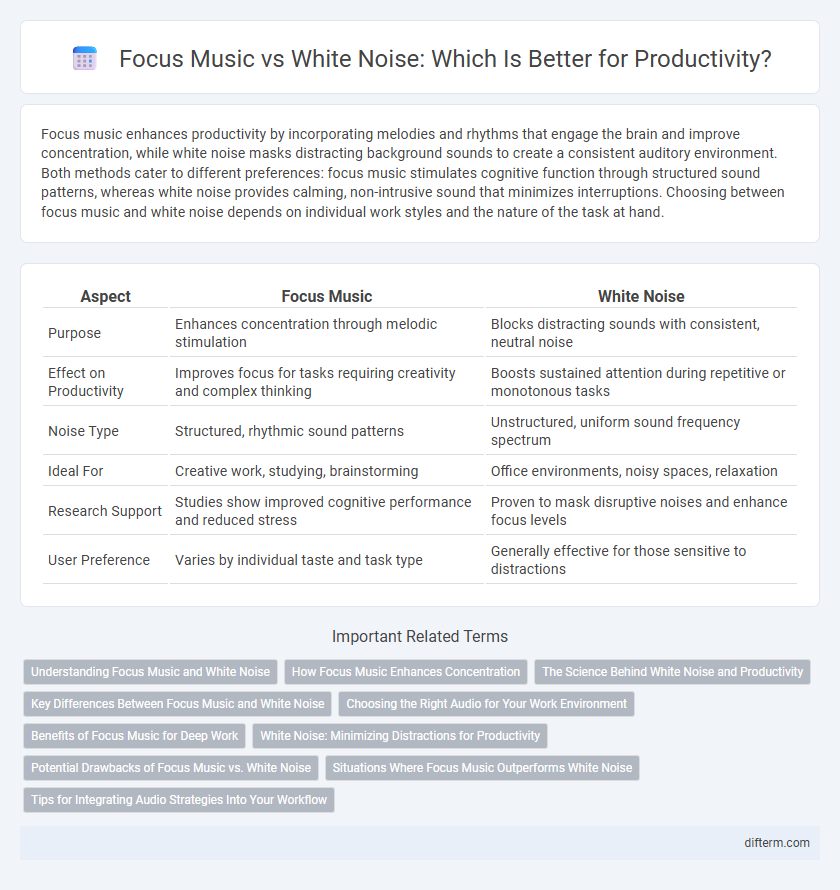Focus music enhances productivity by incorporating melodies and rhythms that engage the brain and improve concentration, while white noise masks distracting background sounds to create a consistent auditory environment. Both methods cater to different preferences: focus music stimulates cognitive function through structured sound patterns, whereas white noise provides calming, non-intrusive sound that minimizes interruptions. Choosing between focus music and white noise depends on individual work styles and the nature of the task at hand.
Table of Comparison
| Aspect | Focus Music | White Noise |
|---|---|---|
| Purpose | Enhances concentration through melodic stimulation | Blocks distracting sounds with consistent, neutral noise |
| Effect on Productivity | Improves focus for tasks requiring creativity and complex thinking | Boosts sustained attention during repetitive or monotonous tasks |
| Noise Type | Structured, rhythmic sound patterns | Unstructured, uniform sound frequency spectrum |
| Ideal For | Creative work, studying, brainstorming | Office environments, noisy spaces, relaxation |
| Research Support | Studies show improved cognitive performance and reduced stress | Proven to mask disruptive noises and enhance focus levels |
| User Preference | Varies by individual taste and task type | Generally effective for those sensitive to distractions |
Understanding Focus Music and White Noise
Focus music utilizes structured melodies and rhythms designed to enhance concentration by stimulating brainwave patterns associated with productivity. White noise provides a consistent auditory backdrop that masks distracting sounds, helping maintain sustained attention in noisy environments. Both methods serve unique roles in improving focus, with music engaging cognitive functions and white noise promoting a distraction-free setting.
How Focus Music Enhances Concentration
Focus music enhances concentration by stimulating brain waves associated with heightened attention and memory retention, such as alpha and beta waves. Unlike white noise, which masks background distractions, focus music provides rhythmic patterns and melodies that engage cognitive processes, promoting sustained mental clarity. Studies reveal that individuals exposed to focus music experience improved task performance, reduced mental fatigue, and increased productivity during complex activities.
The Science Behind White Noise and Productivity
White noise creates a consistent auditory environment that masks disruptive background sounds, improving concentration by reducing sensory distractions. Scientific studies indicate that white noise can enhance cognitive performance by stabilizing neural activity and promoting sustained attention during complex tasks. By improving focus and minimizing interruptions, white noise supports increased productivity, especially in noisy work environments.
Key Differences Between Focus Music and White Noise
Focus music features structured melodies and rhythms designed to enhance concentration and cognitive function, while white noise consists of consistent, unvarying sound frequencies that mask background distractions. Focus music can stimulate brain activity and improve working memory by engaging auditory processing centers, whereas white noise promotes mental clarity by creating a sound blanket that reduces sensory input. The key difference lies in focus music's dynamic auditory patterns compared to the static, uniform nature of white noise, making each suitable for different types of tasks and personal preferences.
Choosing the Right Audio for Your Work Environment
Choosing the right audio for your work environment depends on how your brain processes sound; focus music often includes structured melodies and rhythms that can enhance concentration and creativity for tasks requiring deep thinking. White noise provides a consistent auditory backdrop that masks distracting sounds, making it ideal for open offices or noisy environments where external interruptions are frequent. Experimenting with both types of soundscapes helps determine which improves your productivity and minimizes cognitive overload based on your personal work style and environment.
Benefits of Focus Music for Deep Work
Focus music enhances concentration by reducing distractions and promoting a steady mental state, which boosts productivity during deep work sessions. Unlike random noise, carefully composed focus music incorporates binaural beats and harmonious rhythms that improve cognitive function and sustain attention for longer periods. This auditory environment facilitates flow state achievement, leading to higher quality output and efficient task completion.
White Noise: Minimizing Distractions for Productivity
White noise creates a consistent auditory environment that masks disruptive background sounds, enhancing concentration during work or study. Research indicates that white noise can improve cognitive performance by reducing auditory distractions and promoting sustained focus. Incorporating white noise into productivity routines helps maintain mental clarity and supports efficient task completion.
Potential Drawbacks of Focus Music vs. White Noise
Focus music can sometimes include varying melodies and rhythms that may distract rather than enhance concentration, especially for individuals sensitive to auditory stimuli. White noise provides a consistent and steady sound environment, but prolonged exposure might cause listener fatigue or mask important ambient cues. Both auditory options have potential drawbacks that affect productivity differently depending on personal preference and task requirements.
Situations Where Focus Music Outperforms White Noise
Focus music outperforms white noise in complex cognitive tasks that demand sustained attention and memory retention, such as studying, writing, or programming. Its structured melodies and rhythms can enhance neural entrainment, boosting concentration and creativity, whereas white noise primarily masks distracting sounds without stimulating cognitive engagement. In environments where mental clarity and motivation are crucial, focus music provides an auditory framework that supports productivity more effectively than uniform white noise.
Tips for Integrating Audio Strategies Into Your Workflow
Incorporate focus music or white noise strategically by scheduling dedicated work sessions aligned with audio that enhances concentration, such as instrumental tracks or consistent white noise patterns. Experiment with volume levels and sound types to identify what minimizes distractions and supports sustained attention in your specific workflow. Utilize apps or playlists designed for productivity to seamlessly integrate these audio strategies without interrupting task flow or cognitive performance.
focus music vs white noise Infographic

 difterm.com
difterm.com